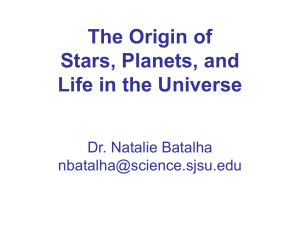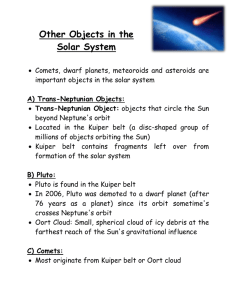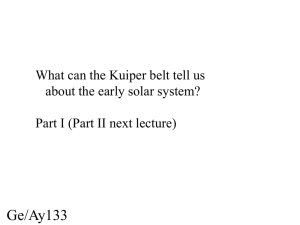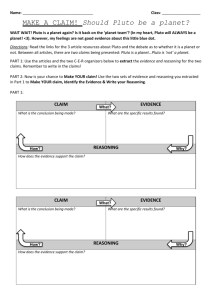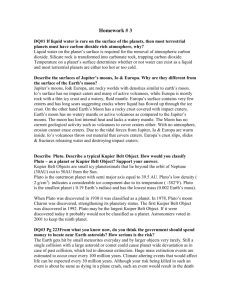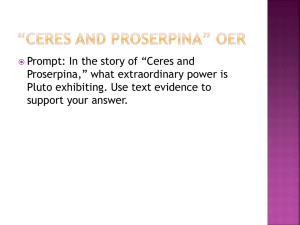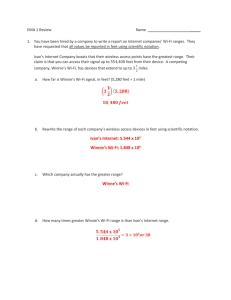Kuiper Belt
advertisement
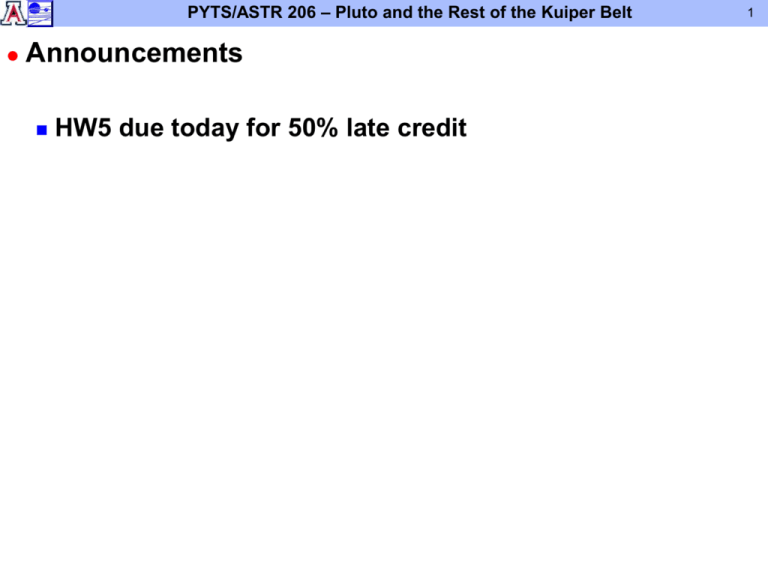
PYTS/ASTR 206 – Pluto and the Rest of the Kuiper Belt Announcements HW5 due today for 50% late credit 1 PYTS/ASTR 206 – Pluto and the Rest of the Kuiper Belt Pluto and the rest of the Kuiper Belt PTYS/ASTR 206 – The Golden Age of Planetary Exploration Shane Byrne – shane@lpl.arizona.edu 2 PYTS/ASTR 206 – Pluto and the Rest of the Kuiper Belt In this lecture… Discovering Uranus and Neptune Pluto Discovery of Pluto Pluto’s strange orbit Pluto’s interior, surface and atmosphere Moons of Pluto and Formation The Kuiper Belt Planet X still to be found Different groups of objects Properties and sizes of KBOs History of the Kuiper Belt Extra-solar Kuiper Belts Why Pluto isn’t a planet New Horizons at Pluto – 2015 3 PYTS/ASTR 206 – Pluto and the Rest of the Kuiper Belt 4 Something was wrong with the orbit of Uranus… Its rate of motion didn’t match that expected from Newton’s law of gravitation Either… Newton’s laws were wrong OR There was another planet perturbing things An extra planet was independently predicted by John Adams – 1843 – but both he and English Astronomers weren’t that interested Urbain LeVerrier – 1846 Looked for and found by Johann Galle Considered a triumph for modern mathematics PYTS/ASTR 206 – Pluto and the Rest of the Kuiper Belt …Uranus wasn’t the only planet with unexpected motions Mercury’s orbit also couldn’t be explained Again, either… Newton’s laws were wrong OR There was another planet perturbing things Massive hunt for the planet ‘Vulcan’ between Mercury and the Sun In this case there was no planet… It turns out that Newton’s laws are slightly wrong… Einstein’s theory of general relativity can explain Mercury’s motion without an extra planet 5 PYTS/ASTR 206 – Pluto and the Rest of the Kuiper Belt Vulcan was a dead end, but not the only dead end Something was still wrong with the orbit of Uranus (and Neptune) Speculation about a 10th planet builds Planet ‘X’ Main Proponent was Perceval Lowell The ‘canals on Mars’ guy Searches for planet X Late 19th and early 20th century Lowell dies but this work continues 6 PYTS/ASTR 206 – Pluto and the Rest of the Kuiper Belt A new technology makes the search for planet X possible Photographic plates were first attached to telescopes in the 1890s Weren’t superseded by CCDs until the 1980s Lead to discovery of many asteroids, new moons etc… 7 PYTS/ASTR 206 – Pluto and the Rest of the Kuiper Belt A ‘blink-comparator’ shows up moving objects Stars don’t move enough to notice Asteroids move very fast Outer solar system objects move very slowly Clyde Tombaugh found a new outer solar system object in 1930 Working from Lowell observatory He looked at millions of stars to find this moving point 8 PYTS/ASTR 206 – Pluto and the Rest of the Kuiper Belt With hindsight Planet X was found in previous plates Orbit was well determined and was larger than that of Neptune Named PLuto partly in honor of Perceval Lowell Did Pluto fit the bill ? Quirks in the orbit of Uranus Explained by uncertainty in Neptune’s mass Pluto had no resolvable disk It must be very small – nothing like another Neptune Pluto was dim Either very small and bright or large and dark Detection of methane ices in 1970s meant it was small and bright Much smaller than any other planet Really a planet? Looked more like Triton than anything else 9 PYTS/ASTR 206 – Pluto and the Rest of the Kuiper Belt Semi-major axis 39.5 AU Period is 248 years Neptune is 30 AU The orbit of Pluto is also odd… Highly inclined: i = 17° Eccentricity is high: e = 0.25 Pluto’s orbit looks more like an asteroid’s orbit than a planet’s It’s so eccentric that it crosses Neptune’s orbit Pluto ranges from 29.6 to 49.3 AU from the sun. Neptune is more or less constant at 30 AU 10 PYTS/ASTR 206 – Pluto and the Rest of the Kuiper Belt Why doesn’t Pluto collide with Neptune? Pluto is in a 3:2 resonance with Neptune Neptune orbits 1½ times for every 1 of Pluto’s orbits Neptune is always far away from Pluto when Pluto crosses inside its orbit This is a very stable arrangement! 11 PYTS/ASTR 206 – Pluto and the Rest of the Kuiper Belt Pluto characteristics Small: 0.18 Earth Diameter ~ 2300 km Low Mass: 0.002 Earth Density of 2000 kg m-3 50-70% Rock 30-50% Water Ice Surface composition Frozen ices Mostly nitrogen Methane And a little derived ethane Carbon Monoxide 12 PYTS/ASTR 206 – Pluto and the Rest of the Kuiper Belt Maps of Pluto’s surface remain poor Spacecraft encounter scheduled for 2015 13 PYTS/ASTR 206 – Pluto and the Rest of the Kuiper Belt Pluto’s Atmosphere Detected with a stellar occultation Very thin atmosphere of mostly Nitrogen Like Triton Pluto is currently receding from the Sun This atmosphere might freeze out as surface ice soon (decades) 14 PYTS/ASTR 206 – Pluto and the Rest of the Kuiper Belt Pluto isn’t alone Large moon Charon discovered in 1978 1200km across (half of Pluto) 17,500km distant, 6.4 day orbit Very circular orbit Sometimes called a double planet Both Pluto and Charon are tidally locked to each other The same face of each body points toward the other all the time No tidal effects 15 PYTS/ASTR 206 – Pluto and the Rest of the Kuiper Belt Charon less dense than Pluto (1600 Kg m-3 vs. 2000) Less rocky material Less geologic activity? Mass of 12% of Pluto Lower mass means no atmosphere Also no atmospheric ices like nitrogen Surface dominated by water-ice Evidence for very recent cryo-volcanism Crystalline Ammonia hydrates and water Loses crystal structure in ~30,000 years We’ll know a lot more in 6 years Spacecraft flyby scheduled 16 PYTS/ASTR 206 – Pluto and the Rest of the Kuiper Belt Other moons discovered in 2005 Nix and Hydra 20-80km size range 17 PYTS/ASTR 206 – Pluto and the Rest of the Kuiper Belt Pluto condensed directly out of the solar nebula Carbon went into CO Oxygen starved nebula had less water ice Pluto is quite rock rich ~ 65-70% Glancing impact generated Charon Charon has spiraled outward due to tidal effects Other small moons exterior to Charon Canup, 2007 18 PYTS/ASTR 206 – Pluto and the Rest of the Kuiper Belt Back to the 1930s Pluto recap… Eccentric and inclined orbit Weird size for the other solar system An ice/rock ‘planet’ beyond the gas giants Enough for people to consider Pluto an ‘anomaly’ 19 PYTS/ASTR 206 – Pluto and the Rest of the Kuiper Belt Another problem weighing on people’s minds… Where did comets come from? Comets in the inner solar system shouldn’t last long Need to be resupplied Similar to the problem of resupplying the Near-Earth asteroids They get resupplied from the asteroid belt Logical solution? There’s a ‘comet belt’ beyond Neptune Proposed by Edgeworth (1943) and Kuiper (1951) The Edgeworth-Kuiper Belt Most people just call it the Kuiper belt now 20 PYTS/ASTR 206 – Pluto and the Rest of the Kuiper Belt First Kuiper Belt Object (KBO) found in 1992 Jewitt and Liu 1992 QB1 Now there are over 1000 known A flat (but fat) disk of objects like the asteroid belt 21 PYTS/ASTR 206 – Pluto and the Rest of the Kuiper Belt What about Pluto? Now just a big Kuiper Belt Object The special 3:2 resonance with Neptune is shared by many objects Called Plutinos Plutinos: All in the 3:2 resonance with Neptune Classical KBOs Called Cubewanoes (after 1992 QB1) Scattered disk objects: Very eccentric orbits Comet source 22 PYTS/ASTR 206 – Pluto and the Rest of the Kuiper Belt Scattered disk objects Have perihelia that approach Neptune An unstable arrangement! They get perturbed into smaller orbits between the giant planets Centaurs Later become Jupiter family comets 23 PYTS/ASTR 206 – Pluto and the Rest of the Kuiper Belt Composition? Much like Pluto Probably much like Neptune’s Moon, Triton Bulk ice/rock compositions Maybe some thin atmospheres Collisions might play an important role Fresh water ice is blue Fast objects have more collisions Faster = higher eccentricity and inclination These faster objects tend to be bluer Some Kuiper Belt Objects are large enough that we might expect interesting surface processes Quaoar was crystalline water ice on its surface indicating a heating event 24 PYTS/ASTR 206 – Pluto and the Rest of the Kuiper Belt Pluto is no longer the largest known Kuiper Belt Object 25 PYTS/ASTR 206 – Pluto and the Rest of the Kuiper Belt Current estimate of about 0.1 Earth masses in the Kuiper Belt More than the asteroid belt Bigger objects Models suggested it should have started with 100 times this 99% of the Kuiper Belt is missing? The Kuiper Belt also seems to have a sharp outer edge 26 PYTS/ASTR 206 – Pluto and the Rest of the Kuiper Belt Kuiper Belt was affected by giant planet migration Neptune thought to have drifted outwards Captures some Kuiper Belt Objects in the 3:2 resonance (like Pluto) Captures one as a moon (Triton) Ejects the other into the inner solar system Where Jupiter tosses them into interstellar space Allows Jupiter to migrate inwards 27 PYTS/ASTR 206 – Pluto and the Rest of the Kuiper Belt It this unusual? Not really Other solar systems have icy debris disks much like our own 28 PYTS/ASTR 206 – Pluto and the Rest of the Kuiper Belt So is Pluto a planet? Not really, it’s just one of a large swarm of similar objects Not even the largest one… Now a planet must: 1. Orbit the Sun 2. Be in hydrostatic equilibrium (i.e. enough gravity to be round) 3. Have cleared its neighborhood of small bodies In 2006 the IAU reclassified Pluto as a ‘dwarf planet’ 29 PYTS/ASTR 206 – Pluto and the Rest of the Kuiper Belt 30 Dwarf planets Five so far, but more likely Ceres Asteroid Belt Pluto Haumea Makemake Eris Scattered disk PYTS/ASTR 206 – Pluto and the Rest of the Kuiper Belt In this lecture… Hunt for planet ‘X’ yielded Pluto in 1932 A small ice-rock planet beyond the gas giants Anomalous orbit puzzled people at the time – resonance with Neptune Tenuous nitrogen atmosphere that might freeze completely as Pluto recedes from the sun Pluto has a (by comparison) large moon The Edgeworth-Kuiper Belt Objects started to be discovered in the 1990s Fall into three dynamical classes Classical belt – Cubewanos (after 1992 QB1) Resonant population – Plutinos (after Pluto) Scattered disk – produces our supply of comets Kuiper belt is a 1% remnant that survived Neptune’s migration Next: Comets Reading Chapter 14 to revise this lecture Chapter 15-7 to 15-9 for next lecture 31
